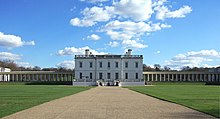Inigo Jones

Inigo Jones (born July 15, 1573 in London , † June 21, 1652 ibid) is considered the first important English architect of classicism .
biography
Little is known about his childhood and youth. Jones student and son-in-law John Webb noted that there were no verified reports of Jones youth. Webb published some biographical notes on Jones' life in the foreword to the book "The most notable antiquity of Great Britain, vulgarly called Stone-Heng, on Salisbury Plain", written by Jones in the 1620s and first published by Webb in 1655.
Jones may have completed an apprenticeship as a carpenter (around 1588–1595) and then spent a few years in Italy. According to Webb, he then briefly served Christian IV of Denmark . From 1605 until the deposition of Charles I by Oliver Cromwell in 1642 , he worked as a set designer and architect for the English royal court. After a further study visit to Italy from 1613 to 1614 together with Thomas Howard, 21st Earl of Arundel , Inigo Jones was appointed Surveyor of the King's Works in 1615 . As general manager, he was responsible for the overall supervision of all structural issues of the court.
Through his work, English architecture was freed from the late medieval tradition and renewed in the spirit of Palladian classicism ( Palladianism , derived from Andrea Palladio ). His most important works are the Queen's House in Greenwich (1616-1635), Banqueting House in Whitehall , London (1619-1622), Prince's Lodging in Newmarket (1619-1621) and Wilton House in Wiltshire (begun 1632, renovated after a fire in 1647) ). The project for Covent Garden (1631–1637) with its arcade structure was Inigo Jones' most important urban development work and subsequently influenced the design of London squares and row houses .
As a set designer, Jones worked from 1604 to the rift in 1631, primarily with the author Ben Jonson . Jones designed the furnishings for the halls, scenery, costumes, lighting and transformations used as a theater. Jones was active as a set designer until 1642, when parliament banned all theater performances. He made a significant contribution to overcoming the Shakespearean stage with an open playing area without moving scenery by introducing a fixed stage frame, a set with a closed perspective, improved by lighting effects, and a rising auditorium with boxes.
In 1643 Jones was removed from his position as Surveyor of the King's Works and arrested in 1645. His property was confiscated but returned in 1646. Oliver Cromwell reinstated him.
swell
- ↑ James Lees-Milne: The age of Inigo Jones; P. 20
- ^ Open Library on "The most notable antiquity of Great Britain, vulgarly called Stone-Heng, on Salisbury plain." From 1655 as well as Open Library on "The most notable antiquity of Great Britain, vulgarly called Stone-Heng, on Salisbury plain. - The 2d ed. “From 1725
literature
- Michael Snodin, John Styles: Design & The Decorative Arts, Britain 1500-1900 . V&A Publ., London 2001, ISBN 1-85177-349-5 .
- John Summerson : Inigo Jones , Pelican series: The Architect and Society , Penguin Books, Harmondsworth, Middlesex, England 1966.
- John Summerson: Architecture in Britain 1530-1830 . Yale University Press, New Haven, Conn. 1993, ISBN 0-300-05886-1 (reprint of the London 1963 edition).
- Wolfgang Beck: Jones, Inigo . In: Manfred Brauneck, Wolfgang Beck (ed.): Theater Lexikon 2. Actors and directors, stage managers, dramaturges and stage designers . Rowohlt's encyclopedia published by Rowohlt Taschenbuch Verlag. Reinbek near Hamburg, August 2007, ISBN 978 3 499 55650 0 , p. 353
Web links
| personal data | |
|---|---|
| SURNAME | Jones, Inigo |
| BRIEF DESCRIPTION | English architect |
| DATE OF BIRTH | July 15, 1573 |
| PLACE OF BIRTH | London |
| DATE OF DEATH | June 21, 1652 |
| Place of death | London |

